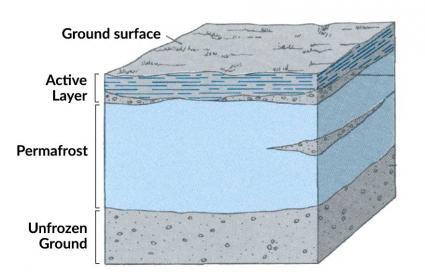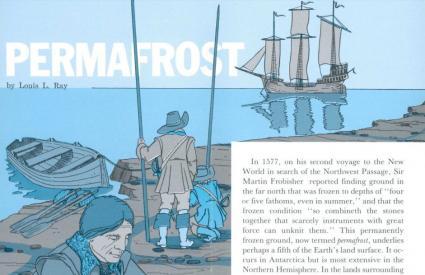What is Permafrost? Why It’s Like the Glue for Rock and Soil

What exactly is permafrost?
Like glue, permafrost doesn’t melt. Instead, it thaws because it contains ground material mixed with ice. For at least 2 years, permafrost is soil or sediment that is permanently frozen at 0°C or colder.
Plus, permafrost also has great implications for humans as it helps regulate the global climate by storing methane in its frozen form and protects valuable ecosystems from the effects of excessive global warming.
“Think of permafrost like glue. The ice is the glue in permafrost which holds the rocks, sand, and soil together.”
What are the layers of permafrost?

The top 1 to 15 centimeters of permafrost is the “active layer”. During the summer, this layer thaws. Then in the winter, it freezes again. Even though permafrost is frozen, it doesn’t necessarily mean it’s covered with snow.
Below the active layer, it’s the permafrost layer. As mentioned, this is mostly ice mixed with soils, rocks, and sand. In general, permafrost ranges from 1 to 1000 meters in depth.
Here are the layers of permafrost:
- Ground Surface: The uppermost layer, exposed to seasonal temperature variations.
- Active Layer: The seasonally thawed layer above permafrost, varying in depth.
- Permafrost: The permanently frozen ground layer, remaining below freezing year-round.
- Unfrozen Ground: Layers beneath permafrost that remain above freezing, usually due to geothermal heat.
Why do engineers consider permafrost melt?
As ice-rich permafrost thaws, the ground settles proportional to how much ice there is in the ground. When building any type of structure, engineers have to consider heaving from permafrost.
For example, the heat used to warm the interior of a building thaws the permafrost beneath. Eventually, the structure begins to cave into the sinking ground without proper design.
- 85% of Alaska is beneath permafrost where the roads are melting from degradation.
- 30% of Yellowknife, Canada sits on Permafrost and has seen ground subsidence on average sink 1-6 cm.

How much permafrost is there?
Permafrost covers about 1/5 of Earth. It’s a prominent feature in the northern landscape that holds most of it together.
In fact, permafrost occupies over 22.8 million square kilometers in the northern hemisphere. This accounts for about 1/4 of its total area.
As you go from north to south, permafrost decreases in thickness. This is due to temperature variation from the northern latitudes.
In this flyover video, you can see how this continuously frozen layer of soil under the Arctic region is thawing.
Does permafrost melt release methane?
Permafrost is loaded with methane. Currently, there are only about 5 gigatons of methane in the atmosphere. But the amount of methane in the Arctic is in the hundreds of gigatons.
As Earth warms up, this has the potential to unlock methane from permafrost as a positive feedback loop. And methane is 25 times better at trapping heat than carbon dioxide
For permafrost, what happens in the north doesn’t stay in the north. This means there could be big changes for the rest of the world as well.
What is Permafrost?
The permafrost is a solid layer of permanently frozen ground, most of which is located in the Northern Hemisphere.
Understanding how these layers interact with one another is an important part of understanding the climatic processes and how it contributes to climate change.
We also have added additional resources below. As always, please send us your comments and questions below.
Additional Resources
The discovery of permafrost traces all the way back to 1577 when Sir Martin Frobisher reported finding this permanently frozen ground in the far north of his journeys. But little attention was paid until the Russians described their engineering problems building on it.
The US Department of the Interior and the US Geological Survey (USGS) provide an excellent overview of permafrost. This includes “what permafrost is” and some of the environmental issues surrounding it. Despite that it’s over 25 years old now, this report on permafrost is still very relevant, today.


North American Plate: Tectonic Boundary Map and Movements
Metamorphic Rocks: Heat, Pressure and Metamorphism
Pangea Ultima: Meet Earth’s Next Supercontinent
Paleozoic Era: Diversification of Life (540 to 252 million years ago)
7 Major Tectonic Plates: The World’s Largest Plate Tectonics
Plate Tectonic Types: Divergent, Convergent and Transform Plates
South American Plate: Tectonic Boundary and Movement
Biological Weathering: How Living Things Break Down Rocks
Mass Wasting: Weathering, Erosion and Transport
How Do Glaciers Form?
How Do Sedimentary Rocks Form?
10 Little-Known Facts About Volcanoes
Coal Formation: How Coal Forms
Earth Timeline: A Guide to Earth’s Geological History and Events [Infographic]